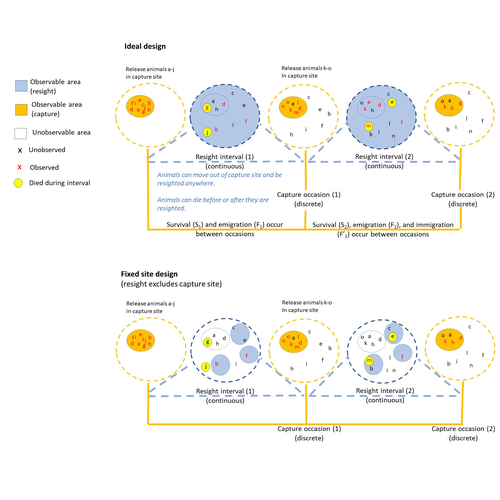
FAY Rémi
- biodemography, Vetagro Sup, Lyon, France
- Conservation biology, Demography, Life history, Maternal effects, Population ecology, Statistical ecology
Recommendations: 0
Review: 1
Review: 1

The importance of sampling design for unbiased estimation of survival using joint live-recapture and live resight models
In the quest for estimating true survival
Recommended by Matthieu Paquet based on reviews by Rémi Fay and 1 anonymous reviewerAccurately estimating survival rate and identifying the drivers of its variation is essential for our understanding of population dynamics and life history strategies (Sæther and Bakke 2000), as well as for population management and conservation (Francis et al. 1998, Doherty et al. 2014). Many studies estimate survival from capture–recapture data using the Cormack–Jolly–Seber (CJS) model (Lebreton et al. 1992). However, survival estimates are confounded with permanent emigration from the study area, which can be particularly problematic for mobile species. This is problematic, not only because CJS models under estimate true survival in populations where permanent emigration occurs (i.e. they estimate “apparent” survival), but also because some factors of interest may affect both survival and emigration (e.g., habitat quality, Paquet et al. 2020), leaving the interpretation of results challenging, for example in terms of management decisions.
Several methods have been developed to account for permanent emigration when estimating survival, for example by jointly analyzing CMR data with data on individuals’ locations at each capture/resighting site (to estimate their dispersal distances; Schaub and Royle 2013, Badia Boher et al. 2023), with telemetry data (Powel et al. 2000), mark recovery data (Burnham 1993, Fay et al. 2019), or with live-resight data (Barker 1997).
The Barker joint live-recapture/live-resight (JLRLR) model can estimate survival when resight data are continuous over a long interval and from a larger area than the capture recapture data. This model becomes particularly promising with the growing collection of data from citizen science, or remote detection tools (Dzul et al. 2023). However, as pointed out by Dzul et al., this model assumes that resight probability is homogeneous across the area where individuals can move, and this assumption is likely violated for example because of non-random movements or because of non-random location of resighting sites.
In their manuscript, Dzul et al. performed a thorough simulation study to evaluate the accuracy of survival estimates from JLRLR models under various study designs regarding the location of resight sites (global, random, fixed including the capture site, and fixed excluding the capture site). They simulated data with varying survival and movement values, varying recapture and resight probabilities, and varying sample sizes. Finally, they also developed and fitted a multi state version of the JLRLR model. They show that JLRLR models performed better than CJS models. Survival estimates were still often biased (either positively or negatively) but they were less biased when sesight sites were randomly located (rather than at fixed locations), when recapture sites were included in the resighting design, and when using the multi state JLRLR model they developed.
This study highlights (multistate) JLRLR models as an alternative to CJS models one should consider when auxiliary resight data can be collected. Moreover, it shows the importance of evaluating not only model performance, but also the efficiency of alternative sampling designs before choosing one for our studies. Hopefully, this study will help the authors and other researchers making a more informed and efficient choice of model and design to estimate survival in their study populations.
References
Jaume A. Badia-Boher, Joan Real, Joan Lluís Riera, Frederic Bartumeus, Francesc Parés, Josep Maria Bas, and Antonio Hernández-Matías. Joint estimation of survival and dispersal effectively corrects the permanent emigration bias in mark-recapture analyses. (2023) Scientific reports 13, no. 1: 6970. https://doi.org/10.1038/s41598-023-32866-0
Richard J Barker (1997) Joint modeling of live-recapture, tag-resight, and tag-recovery data. Biometrics: 666-677. https://doi.org/10.2307/2533966
Kenneth P. Burnham (1993) Marked Individuals in the Study of Bird Populations (ed. J.D. Lebreton), pp. 199–213. Birkhäuser, Basel
Kevin E. Doherty, David E. Naugle, Jason D. Tack, Brett L. Walker, Jon M. Graham, Jeffrey L. Beck (2014) Linking conservation actions to demography: grass height explains variation in greater sage‐grouse nest survival. Wildlife biology 20, no. 6 : 320-325. https://doi.org/10.2981/wlb.00004
Maria C. Dzul, Charles B. Yackulic, William L. Kendall (2023) The importance of sampling design for unbiased estimation of survival using joint live-recapture and live resight models. arXiv, ver.3 peer-reviewed and recommended by PCI Ecology https://doi.org/10.48550/arXiv.2312.13414
Rémi Fay, Stephanie Michler, Jacques Laesser, and Michael Schaub (2019) Integrated population model reveals that kestrels breeding in nest boxes operate as a source population. Ecography 42, no. 12: 2122-2131. https://doi.org/10.1111/ecog.04559
Charles M. Francis, John R. Sauer, Jerome R. Serie (1998) Effect of restrictive harvest regulations on survival and recovery rates of American black ducks. The Journal of Wildlife Management : 1544-1557. https://doi.org/10.2307/3802021
Jean-Dominique Lebreton, Kenneth P. Burnham, Jean Clobert, David R. Anderson (1992) Modeling survival and testing biological hypotheses using marked animals: a unified approach with case studies. Ecological monographs 62.1: 67-118. https://doi.org/10.2307/2937171
Matthieu Paquet, Debora Arlt, Jonas Knape, Matthew Low, Pär Forslund, and Tomas Pärt (2020) Why we should care about movements: Using spatially explicit integrated population models to assess habitat source–sink dynamics. Journal of Animal Ecology 89, no. 12: 2922-2933. https://doi.org/10.1111/1365-2656.13357
Larkin A. Powell, Michael J. Conroy, James E. Hines, James D. Nichols, and David G. Krementz. Simultaneous use of mark-recapture and radiotelemetry to estimate survival, movement, and capture rates. (2000) The Journal of Wildlife Management : 302-313. https://doi.org/10.2307/3803003
Bernt-Erik Sæther, Øyvind Bakke (2000) Avian life history variation and contribution of demographic traits to the population growth rate. Ecology 81.3 : 642-653. https://doi.org/10.1890/0012-9658(2000)081[0642:ALHVAC]2.0.CO;2
Michael Schaub, J. Andrew Royle. Estimating true instead of apparent survival using spatial Cormack–Jolly–Seber models (2014) Methods in Ecology and Evolution 5, no. 12: 1316-1326. https://doi.org/10.1111/2041-210X.12134